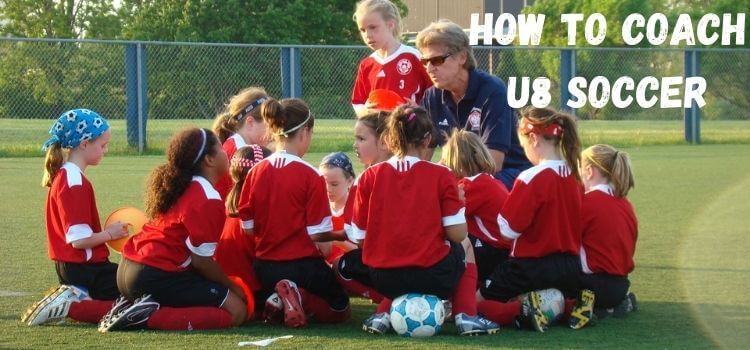As an Amazon Associate, I earn from qualifying purchases
It’s a great and demanding experience to coach U8 soccer. At this stage, children are not just learning about soccer; they are also developing essential life skills. As a coach, your role extends beyond teaching soccer techniques; you are shaping young minds and fostering a love for the game. Let’s explore what it takes to be a successful U8 soccer coach and how to take advantage of this fantastic opportunity.

Understanding U8 Players
Developmental Characteristics
U8 players are typically between the ages of 7 and 8. This age group is energetic, curious, and ready to learn. However, their attention spans are short, and they thrive in engaging and fun environments.
Psychological Aspects
Young players are highly impressionable. They look up to their coach and teammates for validation and encouragement. Building their confidence is crucial, as it can significantly impact their willingness to participate and improve.
Physical Capabilities
Children in this age group are still developing their motor skills. Coordination, balance, and agility gradually improve but vary widely among individuals. Patience and understanding of these physical capabilities are essential for effective coaching.
Setting Coaching Goals
Short-term Goals
Focus on developing basic soccer skills and understanding of the game. Short-term goals should include learning to dribble, pass, and shoot effectively.
Long-term Goals
Encourage a lifelong love for soccer and physical activity. Long-term goals include developing teamwork, sportsmanship, and a positive attitude towards challenges and competition.
Creating a Positive Environment
Encouraging Fun and Enjoyment
The primary goal at this age is to make soccer fun. Incorporate games and activities that children enjoy and that teach soccer skills simultaneously.
Building Team Spirit
Foster a sense of belonging and teamwork. Celebrate individual and team achievements, no matter how small, to build a cohesive unit.
Effective Communication with Young Players
Simplifying Instructions
Use simple, clear, and concise instructions. Visual aids and demonstrations can be very effective in communicating with young players.
Using Positive Reinforcement
Praise effort and improvement rather than just outcomes. Positive reinforcement encourages continued effort and development.
Listening to Players
Players should be encouraged to share their ideas and emotions. Listening to them might facilitate an understanding of their needs and experiences.
Planning and Structuring Practices
Importance of Planning
Well-planned practices are more effective and enjoyable. Ensure each practice has a clear objective and includes various activities to maintain engagement.
Structuring a Practice Session
Start with a warm-up, followed by skill development drills and small-sided games, and conclude with a cool-down. This structure helps maintain a balanced and comprehensive practice session.
Warm-Up and Cool-Down Routines
Importance of Warm-Ups
Warm-ups lower the chance of injury and prime the body for physical action. They should be dynamic and fun.
Simple Warm-Up Activities
Activities like jogging, jumping jacks, and dynamic stretches can be effective warm-ups for young players.
Cool-Down Techniques
Cool-downs help in recovery and prevent muscle stiffness. Gentle stretching and light jogging are suitable cool-down activities.
Skill Development Drills
Basic Dribbling Drills
Set up cone drills in which players dribble the ball through a series of cones. This helps improve control and coordination.
Passing Drills
Pair up players and have them pass the ball to each other. Emphasize accuracy and proper technique.
Shooting Drills
Create shooting drills that are fun and challenging. Use different targets and distances to keep it interesting.
Defensive Drills
Teach basic defensive techniques such as positioning and tackling through simple, controlled drills.
Fun Games and Activities
Integrating Fun into Learning
Use games that incorporate soccer skills. Relay races, dribbling competitions, and small-sided games are excellent choices.
Examples of Fun Soccer Games
- Sharks and Minnows: Players dribble across a designated area while “sharks” try to steal the ball.
- Soccer Tag: Players with a ball try to tag others by touching them with the ball while dribbling.
Teaching Basic Soccer Rules and Concepts
Introducing Soccer Rules
Introduce rules gradually and in a fun way. Use small-sided games to teach concepts like offside, throw-ins, and goal kicks.
Teaching Basic Game Concepts
Explain basic concepts like teamwork, positioning, and movement without the ball. Use visual aids and demonstrations to enhance understanding.
Game Day Preparation
Preparing for Matches
Make sure the players are aware of the timetable and the expectations. Emphasize the importance of teamwork and effort over winning.
Tips for Game Day Management
Keep instructions simple and positive. Focus on effort and improvement rather than the score.
Dealing with Common Challenges
Handling Disruptive Behavior
Address disruptive behaviour calmly and constructively. Set clear expectations and consequences.
Managing Different Skill Levels
Provide activities that cater to varying skill levels. Group players by ability when necessary to ensure everyone is challenged and improving.
Addressing Parent Expectations
Communicate openly with parents about the goals and philosophy of your coaching. Encourage positive support from the sidelines.
Safety Considerations
Ensuring a Safe Playing Environment
Regularly inspect the playing area for hazards. Ensure all equipment is safe and appropriate for young players.
Recognizing and Preventing Injuries
Teach players about the importance of safety and proper technique. Be vigilant for signs of injury and address them promptly.
Evaluating Progress
Monitoring Individual Player Development
Keep track of each player’s progress. Use observations and informal assessments to gauge improvement.
Providing Constructive Feedback
Offer specific and positive feedback. Focus on what players are doing well and how they can improve.
Conclusion
Being a soccer coach for U8 players is a rewarding experience that goes beyond simply teaching the game. It’s about instilling a love for soccer and fostering personal growth in young players. You can significantly impact their lives by understanding their developmental needs, creating a positive environment, and focusing on skill development.
FAQs
Incorporate fun and varied activities that focus on learning through play. Keep sessions dynamic and interactive.
Two to three times a week is ideal, with each session lasting about an hour.
Provide individual attention and tailored drills to address specific areas of difficulty. Encourage persistence and celebrate small achievements.
Communicate the importance of fun, development, and sportsmanship. Set clear expectations and guidelines for parental behaviour.
Concentrate on fundamental abilities such as passing, dribbling, shooting, and game rules comprehension. Stress, having fun, and working as a team.
Read Our More Articles
- How to Play World Cup Soccer Drill: A Comprehensive Tutorial
- How to Coach Soccer to 5 Year Olds: Tips and Strategies
- How to Coach Kindergarten Soccer: Tips and Tricks
As an Amazon Associate, I earn from qualifying purchases


